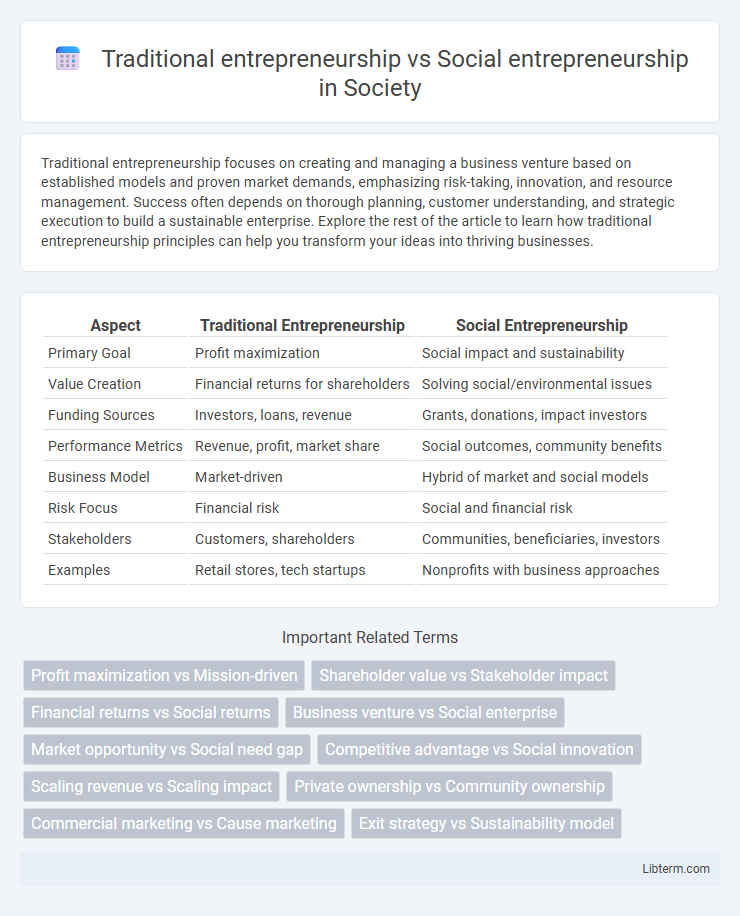Traditional entrepreneurship focuses on creating and managing a business venture based on established models and proven market demands, emphasizing risk-taking, innovation, and resource management. Success often depends on thorough planning, customer understanding, and strategic execution to build a sustainable enterprise. Explore the rest of the article to learn how traditional entrepreneurship principles can help you transform your ideas into thriving businesses.
Table of Comparison
| Aspect | Traditional Entrepreneurship | Social Entrepreneurship |
|---|---|---|
| Primary Goal | Profit maximization | Social impact and sustainability |
| Value Creation | Financial returns for shareholders | Solving social/environmental issues |
| Funding Sources | Investors, loans, revenue | Grants, donations, impact investors |
| Performance Metrics | Revenue, profit, market share | Social outcomes, community benefits |
| Business Model | Market-driven | Hybrid of market and social models |
| Risk Focus | Financial risk | Social and financial risk |
| Stakeholders | Customers, shareholders | Communities, beneficiaries, investors |
| Examples | Retail stores, tech startups | Nonprofits with business approaches |
Defining Traditional and Social Entrepreneurship
Traditional entrepreneurship centers on creating and growing businesses to generate profit and economic value, often focusing on market opportunities and financial returns. Social entrepreneurship prioritizes innovative solutions to social, environmental, or community challenges, aiming to create positive impact alongside financial sustainability. Both forms involve risk-taking and innovation but differ mainly in their primary objectives and measures of success.
Core Objectives: Profit vs Social Impact
Traditional entrepreneurship primarily focuses on generating profit and maximizing shareholder value through market-driven products or services. In contrast, social entrepreneurship centers on creating positive social impact by addressing societal challenges while maintaining financial sustainability. The core objective of social entrepreneurship balances mission-driven goals with economic viability, differing fundamentally from the profit-first approach of traditional business models.
Funding Sources and Financial Models
Traditional entrepreneurship primarily relies on venture capital, bank loans, and angel investors to secure funding, focusing on profit maximization and return on investment. Social entrepreneurship often utilizes impact investing, grants, crowdfunding, and government subsidies, emphasizing sustainable social impact and reinvestment of earnings into mission-driven activities. Financial models in social ventures balance revenue generation with social value creation, contrasting the profit-centric models of traditional businesses.
Measuring Success: Metrics and Outcomes
Traditional entrepreneurship primarily measures success through financial metrics such as revenue growth, profit margins, and market share. Social entrepreneurship evaluates outcomes based on social impact indicators like community well-being, environmental sustainability, and problem-solving effectiveness. Both approaches may utilize customer satisfaction and innovation rates, but social entrepreneurship emphasizes long-term societal benefits alongside financial viability.
Target Market and Beneficiaries
Traditional entrepreneurship primarily targets customers seeking products or services that generate profit, focusing on market demand and maximizing shareholder returns. Social entrepreneurship centers on underserved or marginalized communities, aiming to address social, environmental, or cultural issues through innovative solutions that prioritize social impact over profit. While traditional ventures benefit investors and consumers, social enterprises prioritize beneficiaries such as low-income groups, disadvantaged populations, and communities lacking access to essential resources.
Innovation Approaches in Each Model
Traditional entrepreneurship typically emphasizes market-driven innovation aimed at maximizing profit through product differentiation, efficiency improvements, and competitive advantage. Social entrepreneurship prioritizes mission-driven innovation by developing sustainable solutions to social, environmental, or community challenges, often integrating cross-sector collaboration and stakeholder engagement. Both models employ creative problem-solving but differ fundamentally in their innovation goals, with traditional entrepreneurship focusing on economic returns and social entrepreneurship advancing systemic social impact.
Challenges Faced by Entrepreneurs
Traditional entrepreneurship faces challenges such as securing capital, market competition, and scaling operations while maintaining profitability. Social entrepreneurship encounters difficulties in balancing social impact goals with financial sustainability and often struggles with limited funding sources and measuring social outcomes. Both types of entrepreneurs must navigate regulatory environments and adapt to changing market demands to achieve long-term success.
Scaling Strategies and Growth Potential
Traditional entrepreneurship emphasizes profit-driven scaling strategies such as market expansion, product diversification, and investment in technology to maximize financial growth. Social entrepreneurship prioritizes scaling impact through partnerships, community engagement, and sustainable models that balance social value with financial viability. Growth potential in traditional ventures often targets market share and revenue, while social ventures measure success by social impact and long-term community benefits.
Case Studies: Traditional vs Social Ventures
Case studies of traditional entrepreneurship, such as Apple's innovative product development, highlight profit-driven models emphasizing market share and revenue growth. In contrast, social ventures like TOMS Shoes demonstrate a commitment to addressing social issues through sustainable business practices, integrating philanthropy with commerce. These examples underscore the fundamental differences in objectives, with traditional ventures prioritizing financial returns and social ventures focusing on community impact and long-term social value.
Future Trends in Entrepreneurship
Traditional entrepreneurship continues to evolve with increasing integration of technology and data-driven decision-making to enhance scalability and profitability. Social entrepreneurship is gaining momentum by prioritizing sustainable development goals, leveraging impact investment, and fostering community-based innovation for systemic change. Future trends suggest a convergence where entrepreneurs blend profit objectives with social impact, supported by advancements in digital platforms and global collaboration networks.
Traditional entrepreneurship Infographic

 libterm.com
libterm.com